Chapter 1 This chapter will deal with important general considerations, some of which are often disregarded. It will also outline equipment and instrumentation requirements for general practice. The additional requirements for lagomorphs and rodent dentistry are detailed in Chapter 14. Radiography is mandatory; equipment and techniques are covered in Chapter 7. Practicing dentistry without taking radiographs would be considered negligent in human dentistry. The same applies in veterinary dentistry. Ergonomic considerations are of paramount importance in the layout of the dental operatory. All equipment and instruments should be within easy reach of the operator. Posture is important! Ideally, the operator should be seated (Fig. 1.1). Fig. 1.1 Ergonomic considerations Important patient considerations are as follows: • General anesthesia with endotracheal intubation is essential. This prevents inhalation of aerosolized bacteria (and other debris) and asphyxiation on irrigation and cooling fluid. Chapter 2 covers anesthesia and analgesia for the patient undergoing oral and dental surgery. • A pharyngeal pack (Fig. 1.2) is also recommended during oral and dental treatment. Remember to remove the pack prior to extubation! Fig. 1.2 Pharyngeal pack • The animal should be positioned on a surface that will allow drainage to prevent it becoming wet and hypothermic. This can be achieved by the use of a ‘tub-tank’ or placing the animal’s head on a disposable ‘nappy’, which is frequently replaced. Most animals benefit from a heating pad. Some important equipment and instrumentation considerations are as follows: • There are different degrees of cleanliness required for oral/dental procedures, ranging from visually clean to sterile. • Some equipment and instruments need to be ‘clean’, i.e. units, lamps, tub tables, etc., and need to be wiped clean with an all-purpose disinfectant. • Any instrument that will be used inside the oral cavity but without penetrating the oral mucosa, e.g. examination instruments, burs, scalers, curettes, must be exceptionally clean, as defined by the European Standard (EN)/International Organization for Standardization (ISO), Document 15883. This degree of cleanliness is achieved by mechanical cleaning followed by heat or chemical treatment. This is best achieved using a disinfector, where both cleaning and disinfection occur automatically. Another alternative is placing the instruments in an ultrasound bath or ordinary dishwasher followed by disinfection in an autoclave. A third option is to use chemicals for cleaning and disinfection. The last option is usually limited to equipment/instrumentation where heat disinfection is not suitable, e.g. instruments with plastic handles. • Instruments that penetrate the oral mucosa or the pulp system of the tooth need to be sterile, as defined by the European Standard (EN), Document 556. This entails packaging and sterilization, as detailed by the European Standard (EN)/International Organization for Standardization (ISO), Document 14937. • Suitable (clean, extremely clean, sterile, as required by the procedure) instruments should be available for each patient. Ideally, several pre-packed kits with the required instruments for different procedures, e.g. examination, periodontal therapy, extraction, should be available. • Power equipment requires regular maintenance (daily, weekly) in the practice and regular servicing by the supplier. Draw up checklists for these chores. Check maintenance and servicing requirements with the supplier. Details of how to perform an oral examination and recording are covered in Chapter 6. The following will outline equipment and instrumentation requirements. Personal preferences have been inserted as a guide, where appropriate. The periodontal probe is a narrow rounded or flat, blunt-ended, graduated instrument (Fig. 1.3). Because of its blunt end, it can be inserted into the gingival sulcus without causing trauma (Fig. 1.4). The periodontal probe is used to: Fig. 1.3 Probe and explorer Fig. 1.4 The periodontal probe The dental explorer or probe (Fig. 1.3), a sharp-ended instrument, is used to: • Determine the presence of caries • Explore other enamel and dentin defects, e.g. fracture, odontoclastic resorptive lesions. Periodontal disease therapy is detailed in Chapter 9. Scalers and curettes (Fig. 1.5) are used to remove dental deposits from the tooth surfaces. Each has a handle, a shank and a working end (tip). They require frequent sharpening to maintain their cutting edges. Instrument sharpening is covered later in this chapter. Fig. 1.5 Sickle scaler, universal and Gracey curette
Equipment and instrumentation
Introduction
General considerations
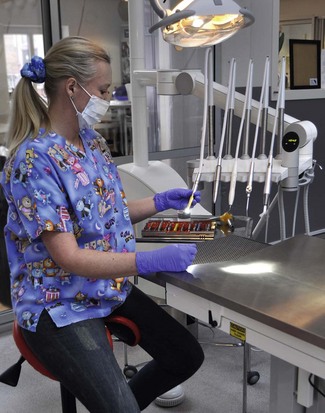
The operator should be seated with all equipment and instrumentation within easy reach.
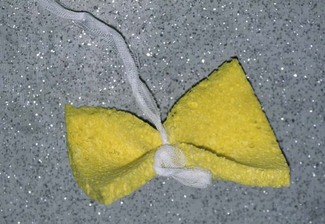
Pharyngeal packing should be used for greater airway security. Commonly used packs include sponge, surgical swabs, gauze bandage. Packs will become saturated with liquid during procedures and will then no longer offer adequate protection and should be replaced as required. It is imperative to remove any packing prior to extubation.
Equipment and instrumentation for oral and dental examination
Periodontal probe

The periodontal probe is a narrow rounded or flat, blunt-ended, graduated instrument while a dental explorer is a sharp-ended instrument. Center picture depicts double-ended instruments; top is a combined explorer and probe and lower (yellow handle) is a combined curved explorer and straight explorer. On the left are close-ups of a curved (top) and straight (bottom) explorer. On the right is a close-up of a periodontal probe.
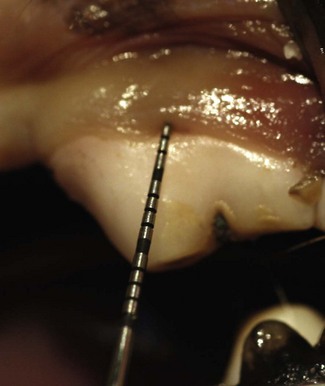
The periodontal probe is a blunt-ended, graduated instrument, which can be inserted into the gingival sulcus without causing trauma.
Dental explorer
Equipment and instrumentation for periodontal therapy
Scaling
Hand scaling instruments
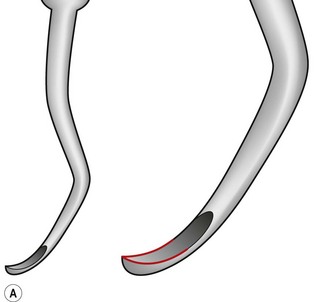
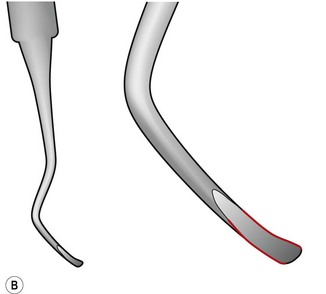
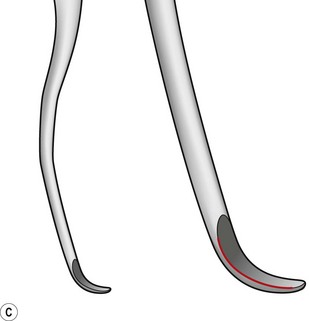
(A) Sickle scaler. Because of its sharp pointed tip it would lacerate the gingiva if inserted subgingivally; this instrument can only be used to remove dental deposits above the gingiva. Note the two cutting edges (highlighted in red). (B) Universal curette. This instrument also has two cutting edges (highlighted in red) but because of its rounded tip it can be used to remove subgingival deposits and restore the root surface to smoothness. It can also be used to remove supragingival dental deposits. (C) Gracey curette. This curette is considered an area-specific curette and has only one cutting side (highlighted in red).
![]()
Stay updated, free articles. Join our Telegram channel

Full access? Get Clinical Tree


Equipment and instrumentation
